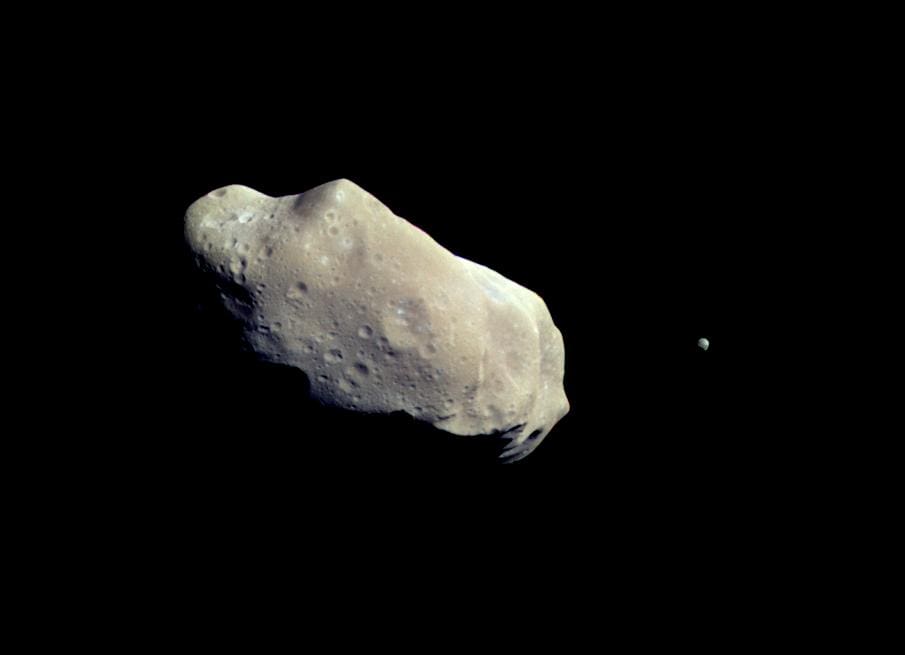Halfway Between the Gutter and the Stars
By Cosmic Strings In UncategorizedHappy International Asteroid Day!
No really! That’s a thing! Look it up!
Asteroids are actually pretty darn cool, when you get right down to it. Big ol’ chunks of primordial solar system stuff floating around in space. They represent some of the oldest known materials in the solar system. They can give us a window into what the early solar system must have been like.
And they are, of course, the stuff a thousand bad sci fi movies are made of.
So in celebration of the humble yet amazing asteroid, I present to you some little-known asteroid facts that just might surprise you.
Fact #1: The asteroid belt…well…isn’t all that full of asteroids.
Everyone knows about the asteroid belt, right? It’s this place between the orbits of Mars and Jupiter that is chock-a-block full of deadly space rocks just waiting to pulverize your spacecraft!
Except it isn’t.
Don’t get me wrong, there are lots of asteroids. But not that many. Remember – there’s a lot of space in space. A ring around the sun about 125 million miles in radius gives you a lot of room to spread out. If you gathered all of the asteroids in the belt together to make a body…it would be a very tiny planet. It would be smaller than our Moon, and pretty low density at that size too. There’s just not enough stuff there to make something big.
Fact #2: You don’t just find asteroids in the belt.
Asteroids can be found all over the solar system. Many of them are in a belt between Mars and Jupiter, yes, but that doesn’t mean you have to be in the belt to be an asteroid. There are rocks trundling around our solar system all over the place.
Fact #3: Many planets have their own attendant asteroids…including the Earth.
We’ve known for some time that the large planets – like Saturn and Jupiter – collect asteroids in gravitational sweet spots called Lagrange points that occur 60 degrees ahead and behind the planet along it’s orbit. These asteroids are called Trojan asteroids, and thanks to a particular balance of gravitational tugs, they just sit there, happily orbiting with their planet. Jupiter has almost 5000 of them. Uranus and Neptune have them too.
And then we found out that Mars has a bunch of them. If tiny little Mars can have 7 Trojan asteroids, what about us? Don’t we get any?
Well, we finally found one. Asteroid 2010 TK7. It’s the only one we have found so far, but hey! We’re in the club! Venus appears to have one as well, and its theorized that Mercury may have them too.
Fact #4: Some asteroids actually have moons of their own!
Why not? Why should planets get to have all the fun? Seriously, there’s no reason an asteroid can’t have moons…and some of them do.


Asteroid Ida. The little spot to the right of the asteroid is its moon, Dactyl. Courtesy NASA.
Fact #5: You can get an asteroid named after you (but it isn’t easy)!
Many companies try to convince you that you can name a star after someone. Plain and simple, you can’t. It’s illegal, by international treaty. But…someone who discovers an asteroid can suggest a name for it if they so choose. The International Astronomical Union still has the final say on accepting the name, but hey! All you need to do now is discover an asteroid! Or…become friends with someone who did. The IAU has these guidelines for naming “minor planets” or asteroids:
- no more than 16 characters long (including any spaces or punctuation);
- preferably one word;
- pronounceable (in some language);
- written using Latin characters (transliterations of names from languages not written using Latin characters are acceptable);
- non-offensive;
- not identical with or even too similar to an existing name of a minor planet or natural planetary satellite.
Given those guidelines…we’ve got some unusual asteroid names in our solar system…
- 91007 Ianfleming (named for Ian Fleming, author and creator of James Bond)
- 3062 Wren (named for Christopher Wren, architect and designer of the Wren Chapel at William & Mary)
- 33434 Scottmanley (named for a Scottish You Tuber)
- 342843 Davidbowie (named for musician David Bowie)
- 110026 Hamill (named for Star Wars actor Mark Hamill)
- 2309 Mr. Spock (named, of course, for everyone’s favorite Vulcan)
Oh, and perhaps you’re wondering why I chose that title. Well, the most amazing (and terrifying, if it’s too big!) way to see an asteroid…is when it comes down into our atmosphere. But we’ll talk more about that on National Meteorite Day.
So now you know. Happy International Asteroid Day, friends!
Kelly






No Comment
Sorry, the comment form is closed at this time.